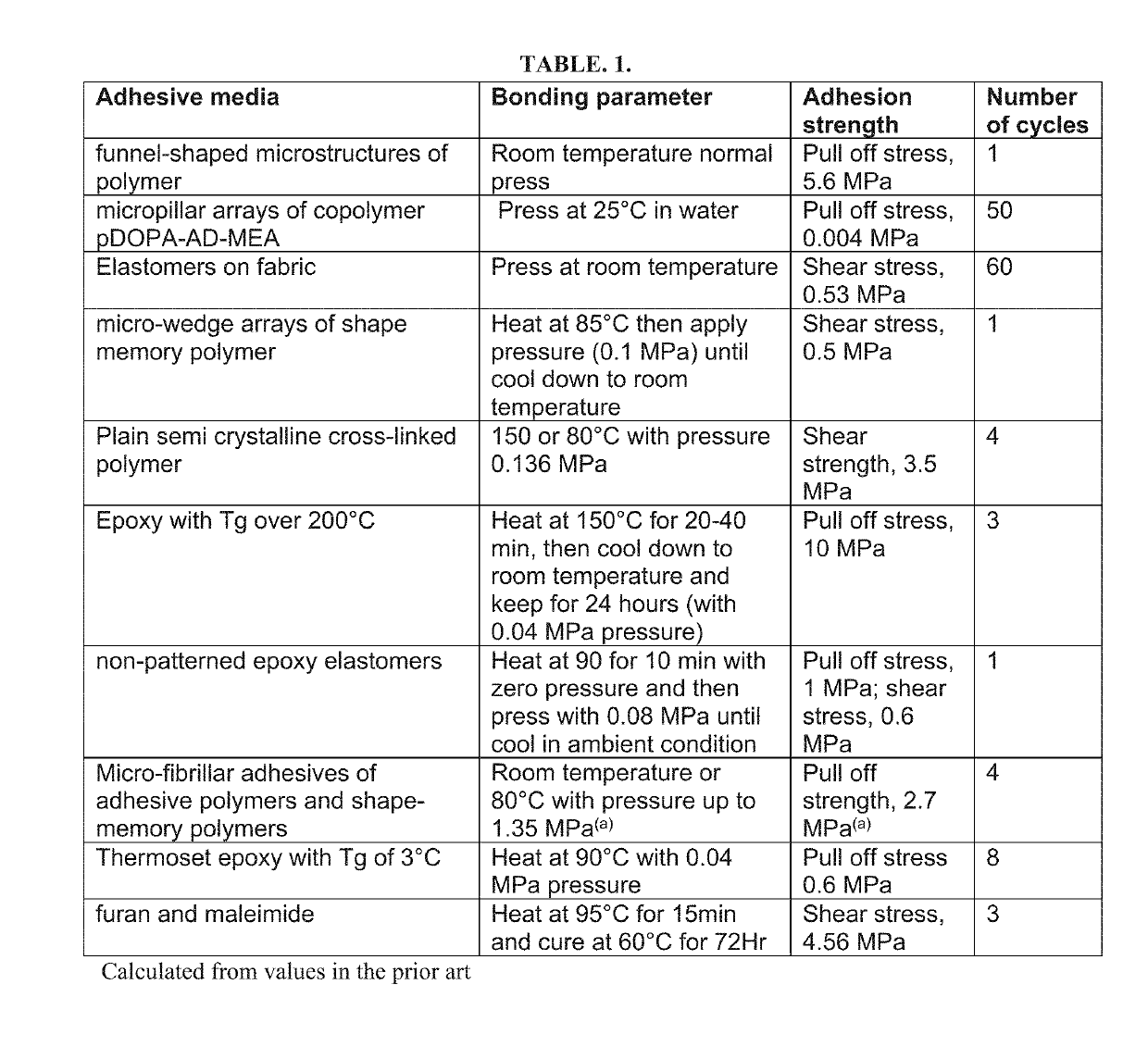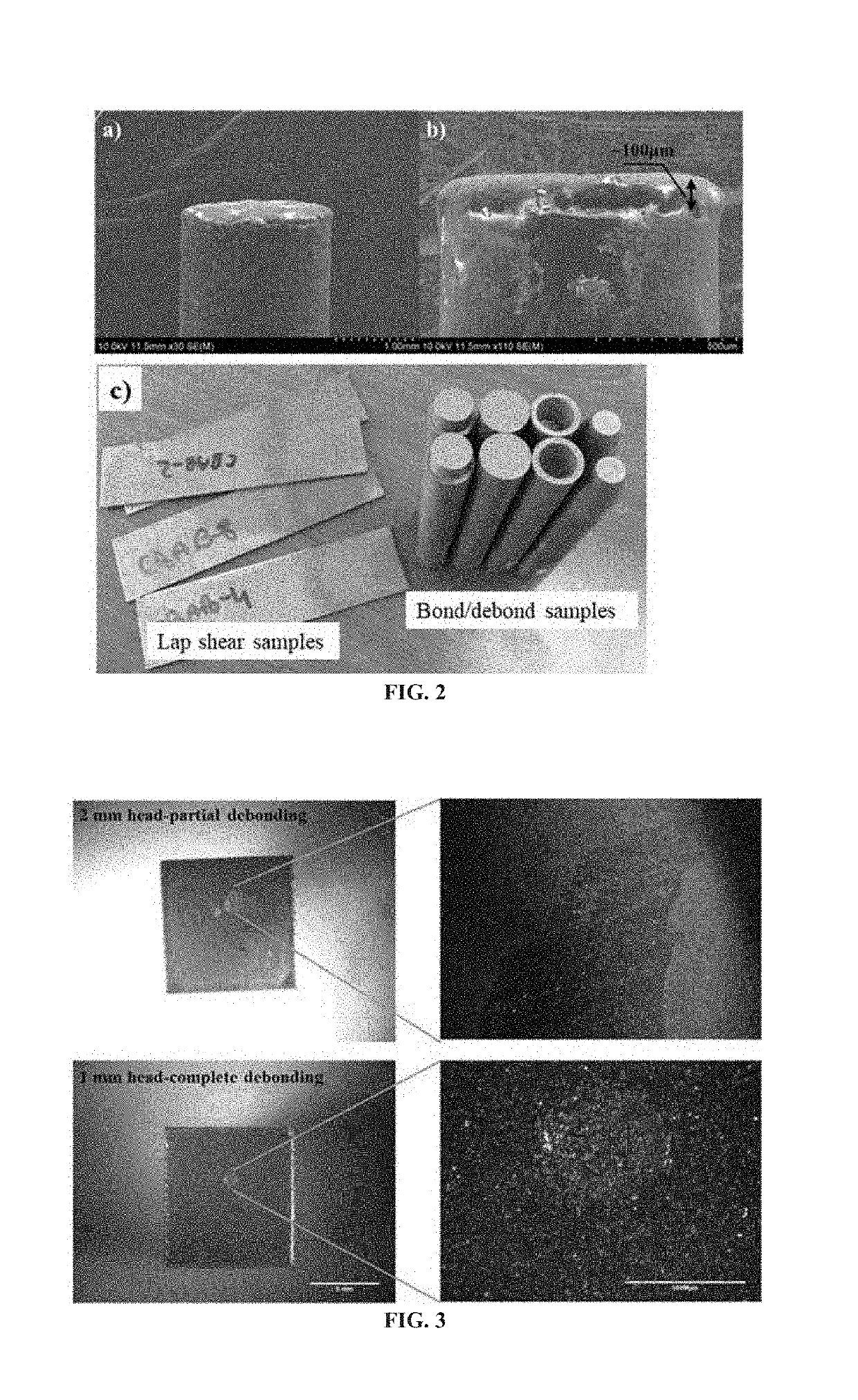Method For Reversible Bonding
a technology of reversible bonding and space frame, which is applied in the direction of metal layered products, synthetic resin layered products, domestic applications, etc., can solve the problems that the available schemes do not address the wide temperature range needed for space applications, and achieve the effect of reducing the mass needed, high strength bonding, and reducing the amount of material used
- Summary
- Abstract
- Description
- Claims
- Application Information
AI Technical Summary
Benefits of technology
Problems solved by technology
Method used
Image
Examples
example 1
[0037]Crosslinkable aromatic copolymer oligomers were synthesized in a batch melt polymerization in a 2 L reactor at 270° C. under an argon atmosphere with the acetic acid by-product distilled out and measured during the process. The reactions proceeded until acetic acid generation was complete. Reactant stoichiometrics were selected to provide a broad range of potential glass transition temperatures (see FIG. 2) by modification of the crosslinker density and main chain stiffness, as determined using Dynamic Mechanical Analyzer (DMA) instrument. Oligomer combinations are designated as the combination of the two oligomer sets (e.g., C1A1, CBAB, etc.). Monomers used for these oligomerizations were: trimesic acid (TMA), isophthalic acid (IPA), 4-acetoxybenzoic acid (4-ABA), hydroquinone diacetate (HQDA), and biphenol diacetate (BPDA). Biphenol diacetate was used as a stiffer and more thermo-oxidatively stable replacement for HQDA. In total, eight such syntheses were carried out to prod...
example 2
[0042]Following the process from Example 1, three consecutive cycles of reversible ITR bonding / debonding were successfully performed over the same bonding area using uniaxial loading fixture in DMA as shown in FIG. 8. The ITR cycles demonstrated quite repeatable trends with respect to displacement over the bond line at the given temperature and tensile stress (pressure) which effectively validates the reversibility concept of the ITR bonding. Another major finding is that the debonding, or reversibility, occurred in cohesive mode as the corresponding surface on the base substrate still contained polymer coating. As seen in SEM (Hitachi 4800) images in FIG. 9, the applied ATSP coating remained on the metal substrate surface. Fracture surface clearly shows the evidence of ductile failure mode—fibrillation / drawing is clearly evident in the lower right close-up image, as compared to surface features of fractured specimen at room temperature. Note the concave appearance was formed due to...
example 3
[0043]Due to the limited force range available in the TA Instruments Q800 DMA as compared to the very high pull-off strengths obtained during these experiments, a specifically developed reversible bonding toolkit was implemented, as shown in FIG. 10. Debonding is a necessary step for demonstration of ITR reversible bonding; however, the force required for debond can be very high, for example to separate a 10 mm diameter bond at room temperature with a pull-off strength of 30 MPa, the force would need to be 2355 N. Hydraulic systems are widely used for high force applications, but hydraulic power is not applicable for in-space conditions. Thus, an electric motor with the lead screw / nut was used to supply force to the press and pull for reversible adhesion application. FIG. 22 shows a 3D diagram for the bond / debond toolkit with the main parts being: 1) stage and shafts, 2) lead screw / nut, 3) sample holders. 4) & 5) top and bottom samples, 6) heater, 7) force transducer, and 8) other e...
PUM
| Property | Measurement | Unit |
|---|---|---|
| temperature | aaaaa | aaaaa |
| temperature | aaaaa | aaaaa |
| temperature | aaaaa | aaaaa |
Abstract
Description
Claims
Application Information
 Login to View More
Login to View More - R&D
- Intellectual Property
- Life Sciences
- Materials
- Tech Scout
- Unparalleled Data Quality
- Higher Quality Content
- 60% Fewer Hallucinations
Browse by: Latest US Patents, China's latest patents, Technical Efficacy Thesaurus, Application Domain, Technology Topic, Popular Technical Reports.
© 2025 PatSnap. All rights reserved.Legal|Privacy policy|Modern Slavery Act Transparency Statement|Sitemap|About US| Contact US: help@patsnap.com



